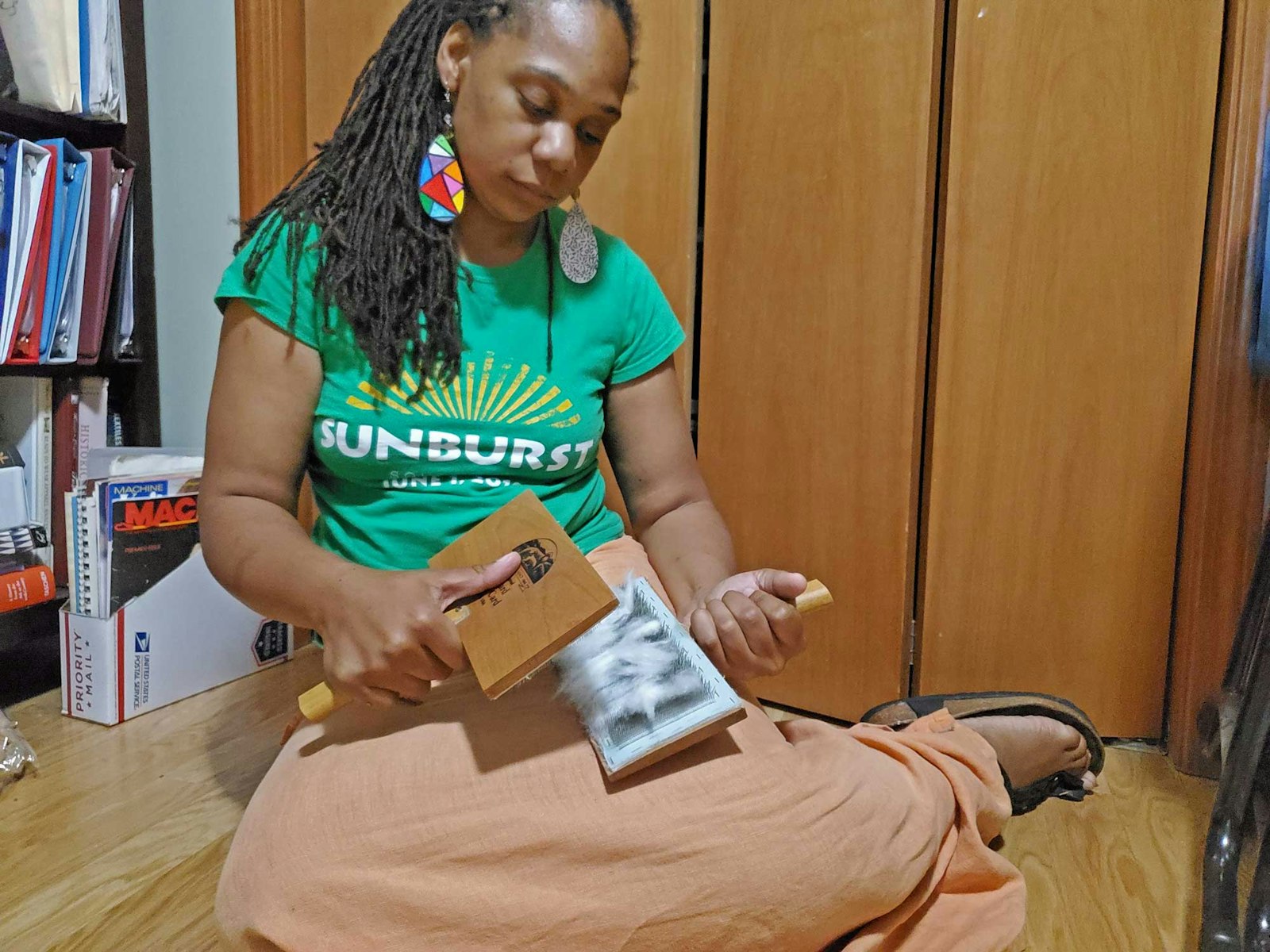There is much to gain from handcarding your own cotton. Just a handful of cotton and a set of handcards can provide the perfect retreat from a bustling day. The softness of the fiber is a delight to your fingertips. Your mind finds focus as you watch the tangled mess of fiber spring into a lofty cloud. All this as the rhythmic sweep of the handcards play a tranquil soundtrack that perfects the mood.
It can take some practice before handcarding can feel like a tranquil activity, and finding the perfect pair of handcards for processing cotton can be a challenge. In my experience, efficient cotton cards need to have 90 tpi (tines per inch) or more. Most people find that handcards with rounded handles that attach to the carding paddles at a slight angle are the most comfortable to use. Once you have your cotton cards, you can start fine tuning your practice. I have a few tips to help.

Handcards with uncarded fiber, shown outdoors. Photo by Melvenea Hodges
3 Tips for Handcarding Cotton
Handcard Hygiene
Remove nepps, embedded fiber, and vegetation from the tines frequently. First, pressing the carders together so the tines enmesh, and with short rocking strokes, the tines will lift unwanted debris to the surface for easy removal. Tweezers are helpful for stubborn bits that remain.
Regularly check your carding cloth for rusty, bent, or broken tines. Correct bent tines when you find them, and replace the carding cloth if necessary. Secure loose handle joins with wood glue or tighten the screw if your cards have them. Reattach a loose cloth with staples. Storing your handcards with tines carefully enmeshed will help prevent them from being bumped and damaged.
Choose Your Cotton Wisely
Start with quality fiber. I’ve worked with as many forms, preparations, and varieties of cotton I get my hands on. What I’ve learned is that fully mature, handpicked cotton is the best fiber you can get. It comes free of vegetation and dirt, and the delicate fibers are unbroken and maintain their natural texture. The cotton is nearly ready to spin after manually teasing it from the seeds with your fingertips. You will have perfectly prepped cotton for spinning with only a few passes on the handcards.

Handcarded rolag with handcards. Photo by Melvenea Hodges
Spinners sometimes have access to mechanically ginned cotton that has not yet been processed into sliver. I suggest avoiding this preparation if possible. It takes more effort to produce a high-quality yarn. You will need to remove crushed vegetation and open up fibers that have become compressed and even twisted from the ginning process. The mechanical harvesting process breaks some of the fibers, so nepps need to be picked out as the cotton is being processed. Cotton that has been handpicked will provide the best carding experience and results.
Avoid Overload
Charge (load) the cards with the right amount of cotton. It can be tempting to load as much cotton as possible onto your handcards, but this will neither save you time nor lighten the task. Adding too much fiber will require more passes between the cards to get the fiber smooth. The larger volume may also conceal nepps and compressed fibers in your rolags.

Carding cotton outdoors. Photo by Waymel Hodges
Here is a quick way to ensure that you have the perfect amount of fiber on your cards: Hold one card stationary in your lap, then gently load the cotton across the carding cloth in short strokes moving opposite the direction of the tines. One pass is usually enough for the tines to catch just enough fiber along the center of the carding cloth. Save the remaining fiber for the next rolag.
—Melvenea
Melvenea Hodges is a fiber artist born and raised in Benton Harbor, Michigan. She is committed to practicing traditional textile techniques in honor and expression of her heritage as an American maker. She intermittently blogs about her latest creations and fiber adventures at traditionsincloth.com.
Read Melvenea's Practical Guide to Ginning Cotton by Hand in the Fall 2021 issue of Spin Off, or on our website here.

